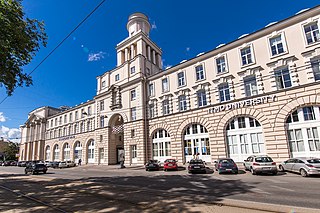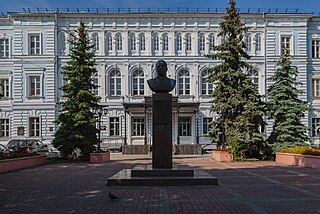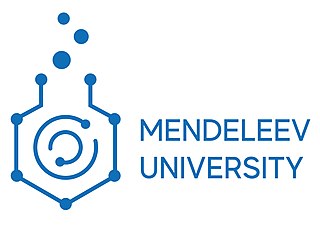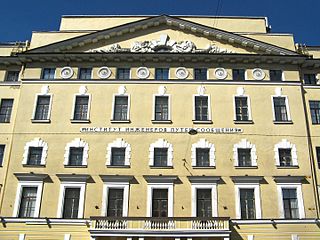Related Research Articles
College and university rankings order higher education institutions based on various criteria, with factors differing depending on the specific ranking system. These rankings can be conducted at the national or international level, assessing institutions within a single country, within a specific geographical region, or worldwide. Rankings are typically conducted by magazines, newspapers, websites, governments, or academics.

National Research Nuclear University MEPhI is a public technical university in Moscow, Russia. It was founded in 1942 as the Moscow Mechanical Institute of Munitions, but was soon renamed the Moscow Mechanical Institute. Its original mission was to train skilled personnel for the Soviet military and Soviet atomic bomb project. It was renamed the Moscow Engineering Physics Institute in 1953, which was its name until 2009.

ITMO University is a state-supported university in Saint Petersburg and is one of Russia's National Research Universities. ITMO University is one of 15 Russian universities that were selected to participate in Russian Academic Excellence Project 5-100 by the government of the Russian Federation to improve their international standing among the world's research and educational centers.

HSE University, officially the National Research University Higher School of Economics is a public research university founded in 1992 and headquartered in Moscow, Russia. Along with its main campus located in the capital, the university maintains three other regional campuses in Nizhny Novgorod, Perm and Saint Petersburg. There is also the Lyceum at HSE University in Moscow.

The National Research State University of Nizhny Novgorod named after N.I. Lobachevsky, UNN, also known as Lobachevsky University, is a public research university in Nizhny Novgorod, Russia, and one of the biggest classical universities of the country. The university is ranked 1,455th in the world in the U.S. News & World Report Best Global Universities 2022-2023.

Perm State University or PSU, PSNRU, is located in the city of Perm, Perm Krai, Russia. Founded in 1916, it claims to be one of the oldest universities in the Ural and eastern territories of Russia. Its current rector is Dmitriy Krasilnikov.

MIREA — Russian Technological University is The Federal State Budget Educational Institution of Higher Education «MIREA — Russian Technological University». It is a higher educational institution in Moscow, Russia, which is an educational, research and innovation complex. It was ranked # 1,960 globally in 2023 by US News & World Report.

Industrial University of Tyumen (IUT) (before 2016, known as the Tyumen State Oil and Gas University and the Tyumen State University of Architecture and Civil Engineering) is a higher education institution in Tyumen, Russia.

D. Mendeleev University of Chemical Technology of Russia (MUCTR) is a public research university in Moscow, and is the largest Russian center for education and research in the field of chemical technology. The history of MUCTR can be traced back to the Moscow Industrial School initially founded in 1898. The university acquired its current name and status in 1992 with its Moscow campus mainly located on Miusskaya Square and in Tushino. The university's other two branches are situated in Novomoskovsk and Tashkent (Uzbekistan). In 2023, the university was ranked # 1,955 by US News & World Report.

Financial University under the Government of the Russian Federation is a public university located in Moscow, Russia. It was considered among top five universities in Russia in 2010 according to Forbes and RBC as well as one of the oldest Russian universities preparing economists, financiers, philosophers, bankers and financial lawyers. It was ranked between # 1,001 and 1,200 globally in 2023 in the QS World University Rankings.

Emperor Alexander I St. Petersburg State Transport University (PGUPS) is a higher education institution specializing in railway transport.

Chelyabinsk State University is a public university in Chelyabinsk, Russia. It was established in 1976 and is considered to be one of the leading academic institutions in the Ural region. Member of Association of Classical Universities of Russia and Eurasian Association of Universities.
The QS World University Rankings is a portfolio of comparative college and university rankings compiled by Quacquarelli Symonds, a higher education analytics firm. Its first and earliest edition was published in collaboration with Times Higher Education (THE) magazine as Times Higher Education–QS World University Rankings, inaugurated in 2004 to provide an independent source of comparative data about university performance. In 2009, the two organizations parted ways to produce independent university rankings, the QS World University Rankings and THE World University Rankings.

The Global Energy Prize is an international award in the field of energy industry which is given for "outstanding scientific research and scientific-technical developments in the field of energy which promote greater efficiency and environmental security for energy sources on Earth in the interests of all mankind".

Kutafin Moscow State Law University (MSAL) is a coeducational and public research university located in Moscow, Russia. It was founded in 1931. MSAL was renamed after Oleg Kutafin in 2012 and was then known as Kutafin University. Its rector is Viktor Blazheev.
The University Ranking by Academic Performance (URAP) is a university ranking developed by the Informatics Institute of Middle East Technical University. Since 2010, it has been publishing annual national and global college and university rankings for top 2000 institutions. The scientometrics measurement of URAP is based on data obtained from the Institute for Scientific Information via Web of Science and inCites. For global rankings, URAP employs indicators of research performance including the number of articles, citation, total documents, article impact total, citation impact total, and international collaboration. In addition to global rankings, URAP publishes regional rankings for universities in Turkey using additional indicators such as the number of students and faculty members obtained from Center of Measuring, Selection and Placement ÖSYM.
Round University Ranking is a Moscow, Russia-based world university ranking, assessing effectiveness of 700 leading world universities based on 20 indicators distributed among 4 key dimension areas: teaching, research, international diversity, and financial sustainability.

Project 5-100 was a special government run program to develop major Russian universities. The program was launched by the Russian Ministry of Education and Science in 2013. It was aimed at improving the prestige of Russian higher education and bring at least five universities from among the project participants into the 100 best universities in the world according to the three most authoritative world rankings: Academic Ranking of World Universities (ARWU), Times Higher Education (THE), and Quacquarelli Symonds (QS) by 2020. However, this goal was never achieved.

IREG Observatory on Academic Ranking and Excellence is an international nonprofit organisation created in 2009 consisting of universities, ranking organisations and third-party organisations associated with academics and university ranking. The organisation's secretariat is based in Warsaw, Poland.
On 4 March 2022, the Russian Union of Rectors signed an address in support of the 2022 Russian invasion of Ukraine. The letter was signed by heads (rectors) of 304 higher education institutions in Russia. It was highly publicized inside Russia, but internationally it only led to further isolation of Russian educational institutions.
References
- ↑ "Ranking". mosiur.org. Retrieved 2023-12-03.
- ↑ "New Ranking from Russia - IREG Observatory on Academic Ranking and Excellence". ireg-observatory.org. November 6, 2016.
- ↑ "Ассоциация составителей рейтингов :: Проекты ассоциации".
- ↑ "Moscow International Ranking "The Three University Missions" released - IREG Observatory on Academic Ranking and Excellence". www.ireg-observatory.org. December 11, 2017.
- ↑ "First Moscow International University Ranking The Three University Missions Released – Moscow International University Ranking News". December 11, 2017.
- ↑ "Russian Three Missions Ranking Published - IREG Observatory on Academic Ranking and Excellence". ireg-observatory.org. December 2, 2018.
- ↑ "Moscow Three University Missions Ranking (MosIUR) 2021". September 1, 2021.
- ↑ "Топ-100 вузов России". raex-rr.com. 2022. Retrieved 2022-06-08.
- ↑ "Зачет по специальности". kommersant.ru. 2023. Retrieved 2023-05-16.
- ↑ "Агентство RAEX впервые опубликовало пилотную версию локальных рейтингов вузов России". tass.ru. 2021. Retrieved 2021-12-16.
- ↑ "МГУ и РАНХиГС заняли первые места в рейтинге самых влиятельных вузов России". tass.ru. 2022. Retrieved 2022-11-25.
- ↑ "Moscow International University Ranking Methodology".
- ↑ "Seminar on Moscow international "Three University Missions" ranking - IREG Observatory on Academic Ranking and Excellence". ireg-observatory.org. June 9, 2017.
- ↑ "The Three University Missions Ranking passes independent audit – Moscow International University Ranking News". June 5, 2018.
- ↑ "THE World University Rankings 2016-2017 passes independent audit". Times Higher Education (THE). May 9, 2016.
- ↑ "Ranking 2017 – Moscow International University Ranking".
- ↑ "Ranking 2018 – Moscow International University Ranking".
- ↑ "MosIUR 2019: Ranking 2019 – Moscow International University Ranking". September 19, 2019.
- ↑ "Ranking 2020 – Moscow International University Ranking". mosiur.org. Retrieved 2023-12-03.
- ↑ "Ranking 2021 – Moscow International University Ranking". mosiur.org. Retrieved 2023-12-03.
- ↑ "Moscow International University Ranking Three University Missions , 2022". mosiur.org. Retrieved 2023-12-03.
- ↑ "Moscow International University Ranking Three University Missions , 2023". rsr-online.ru. Retrieved 2023-08-30.
- ↑ "The Three University Missions Moscow International University Ranking 2023". mosiur.org. Retrieved 2023-12-03.
- ↑ "What direction next for university rankings?". University World News. November 18, 2016.
- ↑ "Brasileiro assume grupo ligado à Unesco que trata de rankings universitários". June 28, 2018.
- ↑ "Moscow Third University Mission Conference - IREG Observatory on Academic Ranking and Excellence". ireg-observatory.org. December 1, 2018.
- ↑ "RUG drops in THE ranking". September 6, 2017.
- ↑ "Russian universities excel in Kremlin-backed rankings". Times Higher Education (THE). December 23, 2017.
- ↑ Ivančević, V., &Luković, I. (2018). National university rankings based on open data: A case study from Serbia. Procedia Computer Science, 126, 1516-1525.
- ↑ Гайсёнак, В. А., Наумовіч, В. А., Самахвал, В. В., & Галынскі, У. М. (2018). Установы вышэйшай адукацыі Беларусі ў сусветных навукова-адукацыйных рэйтынгах: вынікі 2018 года.
- ↑ Гайсенок, В. А., Наумович, О. А., & Самохвал, В. В. (2018). Корреляционные связи позиций вузов в международных рейтингах. Высшее образование в России, (12).
- ↑ Задорожнюк Иван Евдокимович, Калашник Вячеслав Михайлович, Киреев Сергей Васильевич (2018). Московский международный рейтинг вузов в глобальном образовательном пространстве. Высшее образование в России, (6), 31-40.
- ↑ "How to enhance the credibility of academia in public life". universityworldnews.com. December 10, 2022. Retrieved 2022-12-10.
- ↑ Usher, Alex (April 2, 2019). A New Set of International Rankings.